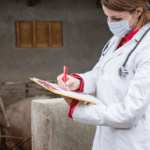 Mysteries
Mysteries  Mysteries
Mysteries  History
History 10 Surprising Stories About the Texas Rangers
 Humans
Humans 10 Philosophers Who Were Driven Mad by Their Own Theories
 Miscellaneous
Miscellaneous 10 Video-Game-Worthy Weapons and Armors from History
 Weird Stuff
Weird Stuff 10 Psychics Who Accurately Predicted Wartime Events
 The Arts
The Arts 10 Pieces of Art Inspired by a Broken Heart
 Health
Health 10 Science Fiction-Sounding New Medical Treatments
 History
History 10 Surprising Facts About the Father of Submarine Warfare
 Space
Space Ten Astonishing New Insights into Alien Worlds
 Weird Stuff
Weird Stuff 10 Bizarre Summer Solstice Rituals Still Practiced Today
 Mysteries
Mysteries Top 10 Haunting Facts About the Ghost Ship MV Alta
 History
History 10 Surprising Stories About the Texas Rangers
 Humans
Humans 10 Philosophers Who Were Driven Mad by Their Own Theories
Who's Behind Listverse?

Jamie Frater
Head Editor
Jamie founded Listverse due to an insatiable desire to share fascinating, obscure, and bizarre facts. He has been a guest speaker on numerous national radio and television stations and is a five time published author.
More About Us Miscellaneous
Miscellaneous 10 Video-Game-Worthy Weapons and Armors from History
 Weird Stuff
Weird Stuff 10 Psychics Who Accurately Predicted Wartime Events
 The Arts
The Arts 10 Pieces of Art Inspired by a Broken Heart
 Health
Health 10 Science Fiction-Sounding New Medical Treatments
 History
History 10 Surprising Facts About the Father of Submarine Warfare
 Space
Space Ten Astonishing New Insights into Alien Worlds
 Weird Stuff
Weird Stuff 10 Bizarre Summer Solstice Rituals Still Practiced Today
10 Amazing Animals That Can Detect Human Diseases
Some animals, like dogs, are well-known for their powerful senses, which can detect many things in the environment that humans cannot perceive. Coupled with the fact they are very responsive to training, people have found all kinds of uses for them, be it sniffing out drugs, explosives, or many other things. But one more recent and very exciting area of research in which animals are being used is disease detection or, more specifically, cancer detection. Dogs are far from the only animals showing promise in this area. Here are ten animals that might actually be able to sniff out cancer in humans.
Related: Top 10 Animals That Evolved To Not Need Eyes
10 Rats
In 2021, researchers in Korea published a paper showing that trained rats were able to detect toluene, an odor-producing liquid that can indicate the presence of lung cancer. You might wonder how exactly rats can communicate what they can smell to people, and this is actually a little bit strange: The researchers trained the rats to jump onto a floating ledge whenever they could smell the toluene.
To make the study more realistic, the rats were not simply presented with samples of toluene among a sequence of other scents. They were presented with real human breath samples, which were collected by humans breathing into plastic bags and then sealed. Some of these samples were later spiked with toluene by the scientists. After over a thousand tests, the rats achieved around 82% accuracy in detecting the toluene.[1]
9 Bees
It is not only mammals that may be able to help humans with deadly disease detection; insects are getting in on the action too. Bees are reported to possess a sense of smell so strong they can detect even just a few molecules of a substance in a room, and they have already been put to use detecting diseases like TB and diabetes.
In addition, they can be trained far more quickly than animals like dogs. Their antennae allow them to more accurately detect specific odors among a mixture of simultaneous smells, as would be the case with human breath samples. Susana Soares, a Portuguese product designer, was studying for her Master’s degree when she developed an elegant glass device known as “Bee’s,” which allows people to safely breathe into a chamber containing the bees, who have been trained with a sugar reward to respond to the detection of certain chemicals.[2]
8 Pigeons
In a rather peculiar—if not downright bizarre—experiment, researchers in the U.S. decided to test whether pigeons could detect breast cancer from images. Surprisingly, they were able to do so just as well as humans! And they did so despite having a brain about the size of a fingertip. Their brains are quite powerful, however, particularly when it comes to images. They have been shown to be able to recall up to 1,800 images, and they can distinguish between people, facial expressions, and even letters in the alphabet.
The pigeons in the cancer study were trained to distinguish microscope images of cancerous and non-cancerous tissues, being rewarded for providing correct answers. When presented with unseen images, they were able to apply what they had learned and correctly distinguish between the images, even when the pictures were zoomed in or out or discolored. It is thought the pigeons could help to validate future image-based methods of cancer detection.[3]
7 Ants
Ants, like bees, possess highly sensitive antennae which enable them to detect all manner of substances that evade human senses. As we now know, specific chemicals released by cancerous tumors can have distinctive smells. However, breath is not the only bodily emission in which these chemicals may appear. The compounds also appear in urine, and in 2023, scientists discovered that ants were very accurate in sensing these compounds in the urine of mice.
It is thought that ants could offer a cheaper and less invasive way of detecting cancer early. But how does one train ants to respond to the presence of the chemicals? Like the other animals on this list, they were trained with rewards. In this case, it was sugar water. When the researchers stopped giving the sugar water, the ants hung around a bit longer in the presence of the urine samples with the cancerous compounds because they were expecting their reward.[4]
6 Dogs
Okay, man’s furry best friend had to feature on this list somewhere. With a sense of smell estimated to be somewhere between 10,000 and 100,000 times better than ours, it probably is not any surprise that dogs can sniff out cancer too. Dogs can detect cancer in expelled matter like breath and urine, much like the ants and bees mentioned earlier in this list. In addition, they can even detect cancer while it is still in situ, meaning it has not spread from the original site where it started.
This is great news since early detection is crucial because cancer is much harder to treat once it has spread. Dogs have been trained to detect cancer in breath, plasma, urine, and saliva, and it takes around 300 samples to train them before they can learn the smell and apply it to new, unseen samples. While some organizations use the canines to detect cancer directly, other researchers are studying their abilities to help build a mechanical nose that will be able to detect cancer in the same way while leaving the dogs to go about their day.[5]
5 Fruit Flies
It might surprise you to learn that fruit flies actually possess less than half the amount of odor-sensing receptors that bees have. So, why use them? Well, possibly because they can communicate much more clearly than bees, as researchers in Germany and Italy discovered. The scientists actually managed to genetically modify the flies to glow the moment they sensed the presence of particular chemicals.
In this study, air containing the scent of breast cancer cells and that of healthy breath tissue was blown toward the flies. Scientists then observed through a microscope the flickering fluorescent patterns on the flies’ antennae as they detected the smells. Apparently, fruit flies have a base genome that lends itself to modification, meaning altering their genes is fairly easy. Add to this that they are cheap to breed and still possess very highly-sensitive olfactory receptors. They offer once again a promising solution to the crucial issue of early cancer detection.[6]
4 Worms
The worms in this research are common roundworms which, at a minuscule 1mm long, are much smaller than the mud-munching earthworms you find in your garden. Roundworms may be less interested in mud, but it seems they are very interested in cancer cells, especially when they are hungry. In the experiment, scientists from Korea placed around 50 worms on microscope slides, along with healthy human cells and cancerous cells. About 70% of the worms wriggled their way toward the cancer cells.
While it is unknown why cancer cells consistently appeal to the worms, scientists have a theory: Cancer cells emit many of the same odor molecules as rotten apples, something we all know is attractive to other species of worms. The next step is to see if they can detect cancer when presented with substances like urine or breath rather than being directly presented with cancer cells.[7]
3 Locusts
Like fruit flies, locusts are something of a scientific staple; scientists already know a lot about their characteristics and even how their brains are wired. When it turned out they also possess a powerful sense of smell, it was only natural to study their use in disease detection, although not before they had been tested to detect explosives. However, researchers did not train these very creepy crawlies to respond to cancerous cells. Instead, they attached electrodes to the brains of the locusts to see how they responded to the gases produced by cancerous and healthy cells.
In fact, it turns out the locusts could do more than just make a binary distinction between healthy and cancerous cells. They could actually differentiate between three types of cancer. Impressive as that may be, you may be relieved to hear the scientists plan to replicate the biology that allows for such highly-sensitive detection and do not intend for doctors to test patients with live locusts.[8]
2 Cats
This is where science begins to give way to speculation, although cats do have surprisingly good noses. Though not quite as powerful as a dog’s, cats’ noses are significantly greater than humans, and it is believed they can actually differentiate between smells better than both dogs and humans. Certainly, there is some promise there, although there are yet to be any scientific studies. There are some interesting anecdotes, though.
In 2010, a woman from Franklin, Tennessee, visited her doctor after a mysterious bruise showed up on her chest in a place where her cat had been continuously pawing and pouncing the previous evening. She discovered it was breast cancer. A year earlier, a story made headlines in Canada in which a man from Calgary attested that his cat had alerted him to his lung cancer with his persistent pawing at his owner’s left side. The owner credits his cat, Tiger, who apparently was not previously very cuddly, with saving his life.[9]
1 Humans
It is clear from the many studies listed above that cancers do have specific smells, which begs the question of whether humans are also able to detect them. Of course, our noses are not as powerful as many other animals, especially dogs. However, a super-smelling nurse from Scotland believes it might just be possible for some people to smell cancer.
Joy Milne, a former nurse, noticed a change in the smell of her husband’s skin a whole 12 years before he was diagnosed with Parkinson’s disease. Later, her amazing olfactory abilities were put to the test in clinical trials, which revealed she could detect particular molecules in the sebum produced by Parkinson’s disease. She reported that when she worked as a nurse, cancer patients had a unique smell to her.
In 2018, she visited a training center for cancer-sniffing dogs to test her own abilities by sniffing masks into which cancer patients and healthy people had breathed. The results were very promising, and she correctly identified to whom most of the masks belonged. However, some sources claim any smells detected by humans are not likely to be directly the smell of cancer but of symptoms or side-effects of treatment. It seems the jury may still be out.[10]








